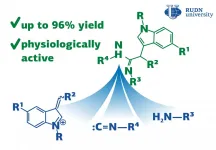RUDN University chemists propose a one-step synthesis of substances for medicine
2021-07-15
(Press-News.org) The RUDN University chemists have discovered a reaction for the synthesis of acetimidamides, heterocyclic compounds with biological activity that can be used for the synthesis of hormones, anti-inflammatory and other medical drugs. The reaction goes in one step with an efficiency of up to 96%. The results are published in the journal Molecules.
Traditional chemical synthesis goes in several stages and requires the isolation and purification of intermediates at each stage. It is not efficient and not environmentally friendly as it increases the loss of substances and the consumption of solvents, and there is a problem of waste disposal. Therefore, modern chemistry is trying to replace multi-stage reactions with multicomponent ones, in which several compounds react to form a product in a single stage. Reactions with isocyanides are the most popular in multicomponent chemistry. Isocyanides are organic compounds with high reactivity. RUDN University chemists have discovered a new three-component reaction with isocyanides that results in a heterocyclic compound with biological activity, acetimidamides. They contain a fragment of indole, which is used for the synthesis of hormones, indomethacin, and other drugs. This work is a development of the famous Ugi reaction.
"Isocyanide-based multicomponent reactions play an outstanding role in the syntheses of heterocycles, biologically relevant compounds and for diversity-oriented synthesis. In the case of the famous Ugi reaction, isocyanide interacts with iminium salt generated in situ. The potency of methods, based on the Ugi reaction, increases with the possibility of subsequent modification or cyclization of obtained products of multicomponent reaction. This is promising from the point of view of medical chemistry", said Nikita Golantsov, PhD, Professor of the Department of Organic Chemistry of the RUDN University.
Apart from isocyanides, the new three-component reaction involves a 3-arylidenindoleninium salt and an amine. In total chemists used 8 salts and 13 amines. To choose the optimal reaction conditions, they tested 6 types of solvents, alternated the reaction time and temperature. After the reaction was completed, the chemists isolated the final product by treatment with a saturated baking soda solution followed by chromatography and studied its composition and structure using various methods, including nuclear magnetic resonance (NMR) spectroscopy.
In total, the RUDN University chemists obtained 16 acetimidamides. When using isocyanoacetic ester, imidamides were further cyclized with the formation of an imidazolone fragment. Thus, a series of 19 imidazolones containing an indole substituent was synthesized. The most suitable solvent was acetonitrile. It allowed to minimize the formation of by-products. After three hours at a temperature of 20?, the reaction yield (the ratio of the actual mass of the product obtained to the theoretical one), was 75%. And after 12 hours, the output reached 96%. Chemists tried to accelerate the reaction by increasing the temperature, but this attempt was unsuccessful due to a tar formation and an increase in the amount of the by-product.
"These reactions furnish a new practical synthetic approach to a series of compounds with a privileged indole scaffold, which are prospective choices for seeking new physiologically active compounds", said Nikita Golantsov, PhD, Professor of the Department of Organic Chemistry of the RUDN University.
INFORMATION:
[Attachments] See images for this press release:

ELSE PRESS RELEASES FROM THIS DATE:
2021-07-15
Scientists have uncovered a way to control many genes in engineered yeast cells, opening the door to more efficient and sustainable production of bio-based products.
The study, published in Nucleic Acids Research by researchers from DSM's Rosalind Franklin Biotechnology Center in Delft, the Netherlands, and the University of Bristol, has shown how to unlock CRISPR's potential for regulating many genes simultaneously.
Baker's yeast, or Saccharomyces cerevisiae to give it it's full name, is considered as a workhorse for biotechnology. Not only has it been used for producing bread and beer for thousands of years, but today it can also be engineered to produce an array of other useful compounds that form the basis of pharmaceuticals, fuels, and food additives. However, achieving ...
2021-07-15
According to the World Health Organization, a third wave of COVID infections is now all but inevitable in Europe. A COVID tracker developed by IIASA researcher Asjad Naqvi, aims to identify, collect, and collate various official regional datasets for European countries, while also combining and homogenizing the data to help researchers and policymakers explore how the virus spreads.
While many comparisons have been made between the COVID-19 pandemic and similar events in history, one thing sets this pandemic apart from others: the unprecedented amount of knowledge and data that is constantly being generated to understand how the pandemic is unfolding. For a high-income region like Europe, the quality of information made available on a daily basis is exceptionally ...
2021-07-15
The Institut Pasteur, in partnership with the French National Health Insurance Fund (CNAM), Santé publique France and the Ipsos Social Research Institute, recently presented the results of the ComCor epidemiological study on circumstances and places of infection with the SARS-CoV-2 virus. The aim of the study was to identify the socio-demographic factors, places visited and behaviors associated with a higher risk of infection with SARS-CoV-2. The study contains two parts:
the first part describes the circumstances of infection of index cases diagnosed positive for SARS-CoV-2 during the curfew period, especially when the person considered as the source of infection is known;
the ...
2021-07-15
PHILADELPHIA - People who struggle with serious mental illnesses are more likely to die early - about 10 to 30 years early - than those without mental illness from any cause. Many factors contribute to this disparity including poor access to care, undetected health conditions and difficulty managing chronic health conditions. Addressing physical illness in those with serious mental illness has been a major challenge. To address this, researchers tested a peer-led intervention called the Bridge that helps patients with mental illness prioritize their health, access health care and develop skills to self-manage their health. The approach showed a 50% reduction in emergency room use for those in ...
2021-07-15
University of Otago scientists have opened the door to improved treatment of brain dysfunction which causes psychosis.
Dr Ryan Ward, of the Department of Psychology, says he and a team of researchers have been working on ways to model schizophrenia symptoms in animal models.
"Psychosis is a debilitating aspect of schizophrenia and, while current drugs treat it well, they have horrendous side effects which lead to poor quality of life for patients. Research which can identify specific mechanisms of the dysfunction can provide more precise drug targets for treatment, improving patient ...
2021-07-15
WASHINGTON--A new study, published by the North American Menopause Society in the journal Menopause, found a plant-based diet rich in soy reduces moderate-to-severe hot flashes by 84%, from nearly five per day to fewer than one per day. During the 12-week study, nearly 60% of women became totally free of moderate-to-severe hot flashes. Overall hot flashes (including mild ones) decreased by 79%.
The study, called the WAVS trial--the Women's Study for the Alleviation of Vasomotor Symptoms-shows that diet changes can be much more powerful for treating ...
2021-07-15
A small regulatory RNA found in many problematic bacteria, including Escherichia coli, appears to be responsible for managing the response of these bacteria to environmental stresses. Professor END ...
2021-07-15
If you didn't have a brain, could you still figure out where you were and navigate your surroundings? Thanks to new research on slime molds, the answer may be "yes." Scientists from the Wyss Institute at Harvard University and the Allen Discovery Center at Tufts University have discovered that a brainless slime mold called Physarum polycephalum uses its body to sense mechanical cues in its surrounding environment, and performs computations similar to what we call "thinking" to decide in which direction to grow based on that information. Unlike previous studies with Physarum, these results were obtained without giving ...
2021-07-15
DALLAS, July 15, 2021 -- Statement Highlights:
The new scientific statement, "Primary Care of Adult Patients After Stroke," acknowledges the importance of primary care in the system of care for patients with stroke, summarizing the available literature and providing a roadmap for holistic, goal-directed and patient-centered care.
The statement is published today in Stroke, a journal of the American Stroke Association, a division of the American Heart Association.
Primary care professionals provide essential comprehensive and consistent care to patients ...
2021-07-15
"The solar energy-to-electricity conversion of perovskite solar cells is unbelievably high, around 25%, which is now approaching the performance of the best silicon solar cells," says Professor László Forró at EPFL's School of Basic Sciences. "But their central element is lead, which is a poison; if the solar panel fails, it can wash out into the soil, get into the food chain, and cause serious diseases."
The problem is that in most of the halide perovskites lead can dissolve in water. This water solubility and solubility in other solvents is actually a great advantage, as it makes building perovskite solar panels simpler and inexpensive - another perk along with their ...
LAST 30 PRESS RELEASES:
[Press-News.org] RUDN University chemists propose a one-step synthesis of substances for medicine



